In some ways, they’re total opposites. One loves the sea, the other the land. One favoured books in school, the other not so much. One is solemn and reflective, the other witty and forthright.
But still, despite their seeming differences, in the presence of brothers Séamus and Breanndán Ó Beaglaoich, you get the sense they’re on the same wavelength. That they have a connection perhaps only brothers can. It’s evident in their shared love of music, their shared passion for the Irish language and their common wish to keep rural communities vibrant and viable.
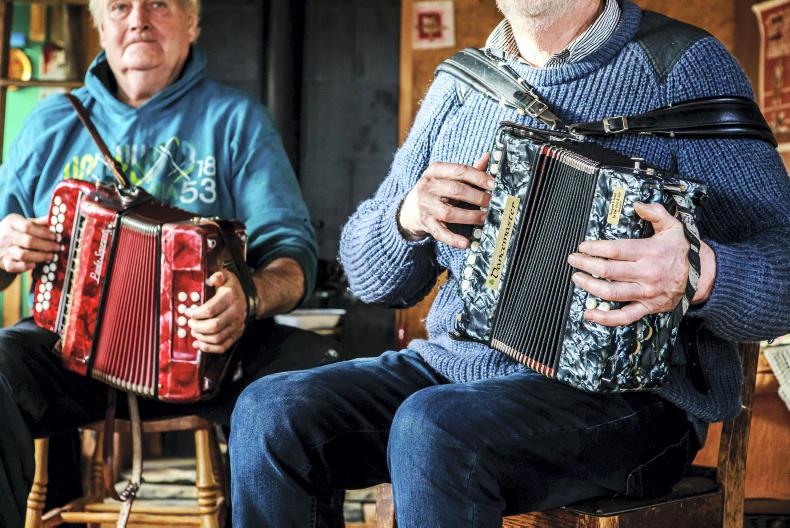
Séamus and Breanndán Ó Beaglaoich at home in Baile na bPoc, Co Kerry. \ Philip Doyle
As we chat, they regularly break into a few lines of Gaeilge between themselves, such is the habit, and then come back to translate. The brothers also have a seanfhocal for every eventuality – too many to start into.
Séamus and Breanndán are well-known traditional musicians from west Kerry, but speaking with them you’d scarcely know it. The only giveaway is the 10 or more accordions scattered around Breanndán’s sitting room.
Both are box players. Our photographer and I are lucky enough to get a short, private concert when we visit them at Breanndán’s home.
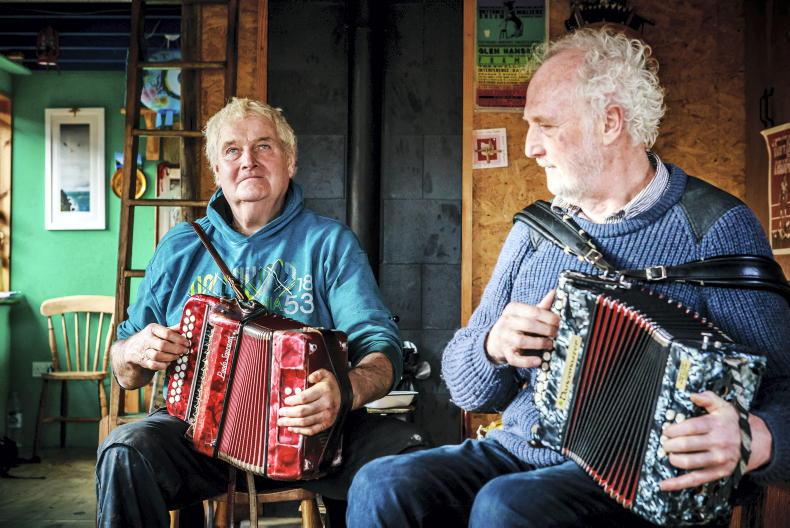
Séamus and Breanndán Ó Beaglaoich at home in Baile na bPoc, Co Kerry. \ Philip Doyle
Casually, Breanndán drops into the conversation he was playing in the National Concert Hall with Glen Hansard one night. Séamus has been on tour with Mary Black and in 2013 was the TG4 Amhranaí na Bliana (Singer of the Year). That’s just to give you a small flavour.
As the farmer of the two, Séamus loves the land. Breanndán is more into the sea. He was sea swimming ever before there was mention of a dryrobe and he also rows.
For three consecutive years he completed a Camino, but not the walking pilgrimage that springs to mind. With others he rowed in a Naomhóg, a traditional west Kerry Currach, from Ireland to Wales, onto Cornwall and then down the coast of mainland Europe to Spain and Portugal.
The man who can’t be moved
This home of Breanndán’s is actually in itself sort of famous. It’s situated in the Gaeltacht, 15 minutes outside Dingle, where they’re from in Baile na bPoc. It’s on what was their family farm growing up.
You see, Breanndán was in a 15-year battle for planning permission. He had been attempting to secure planning from Kerry County Council for a house on his land since 2005. Last October, he was granted it after an appeal to An Bord Pleanála.
The key thing that needs to be mentioned at his juncture about Breanndán’s current home, is that it’s built on the back of an articulated trailer. Now, at a glance, one would hardly know it. It has a toilet, a bedroom, a small kitchen and a spacious sitting room.
After 10 years of planning struggles, in 2015 the house on the trailer was born out of total frustration, Breanndán says.
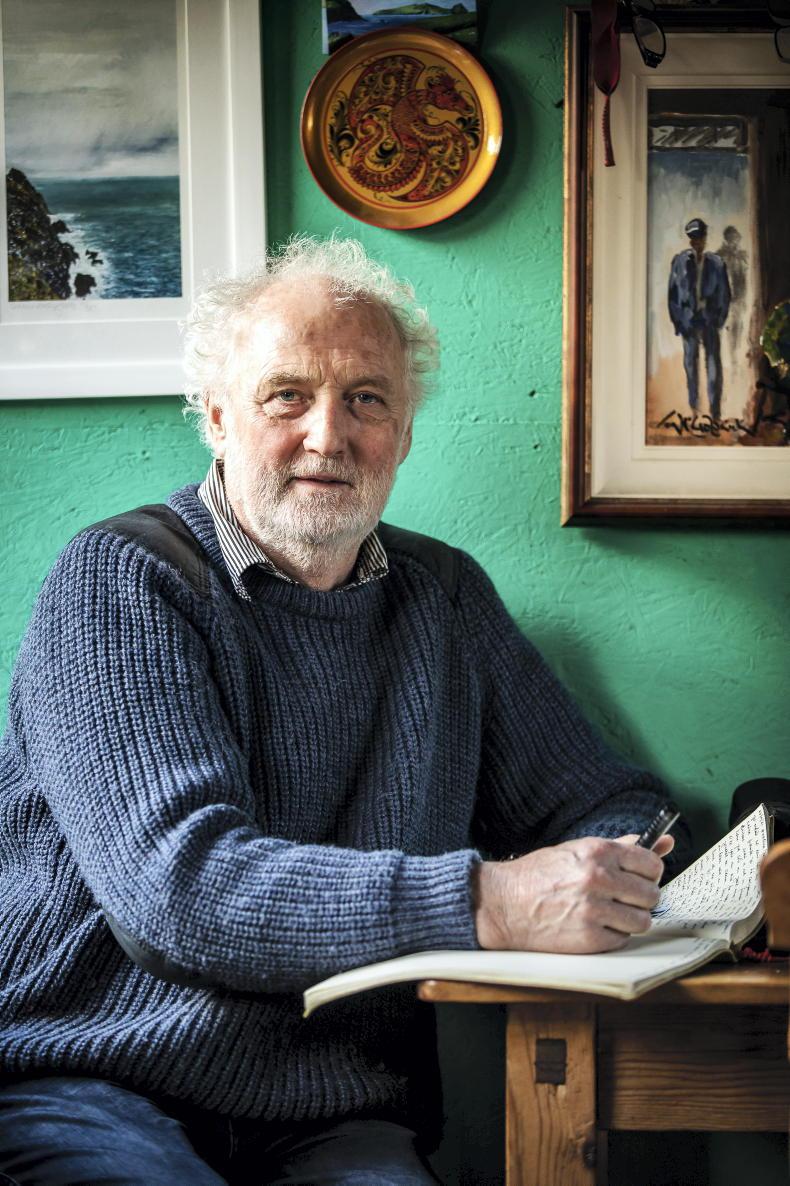
Breanndán Ó Beaglaoich at home in Baile na bPoc, Co Kerry. \ Philip Doyle
“I lived for almost a year in a caravan down there belong ing to Séamus. I started planning this and I said, ‘I’m not going to live in a caravan, I’m going to live in a house.’ I looked at this website called Tiny Homes.
“I decided to build a house, that if all came to all, I could actually move it off the land. I can still move this off the land. I built nothing here, I just drove my truck onto the land.”
Séamus interjects with a laugh: “If you get tired of the neighbours you can move.”
An articulated trailer arrived from Listowel and the house was built on it in Séamus’s yard just a short distance away. At 44ft long and 8ft wide, the house was actually designed and constructed by a ship builder, which is fitting due to Breanndán’s love of the sea.
Séamus tells Breanndán to show us the video. Breanndán finds a tablet and a short time later the distinct sound of accordions blasts from it. The video shows Séamus and Breanndán aloft on a tractor, playing music as the house on the trailer is toed onto the land, cheered on by local people.
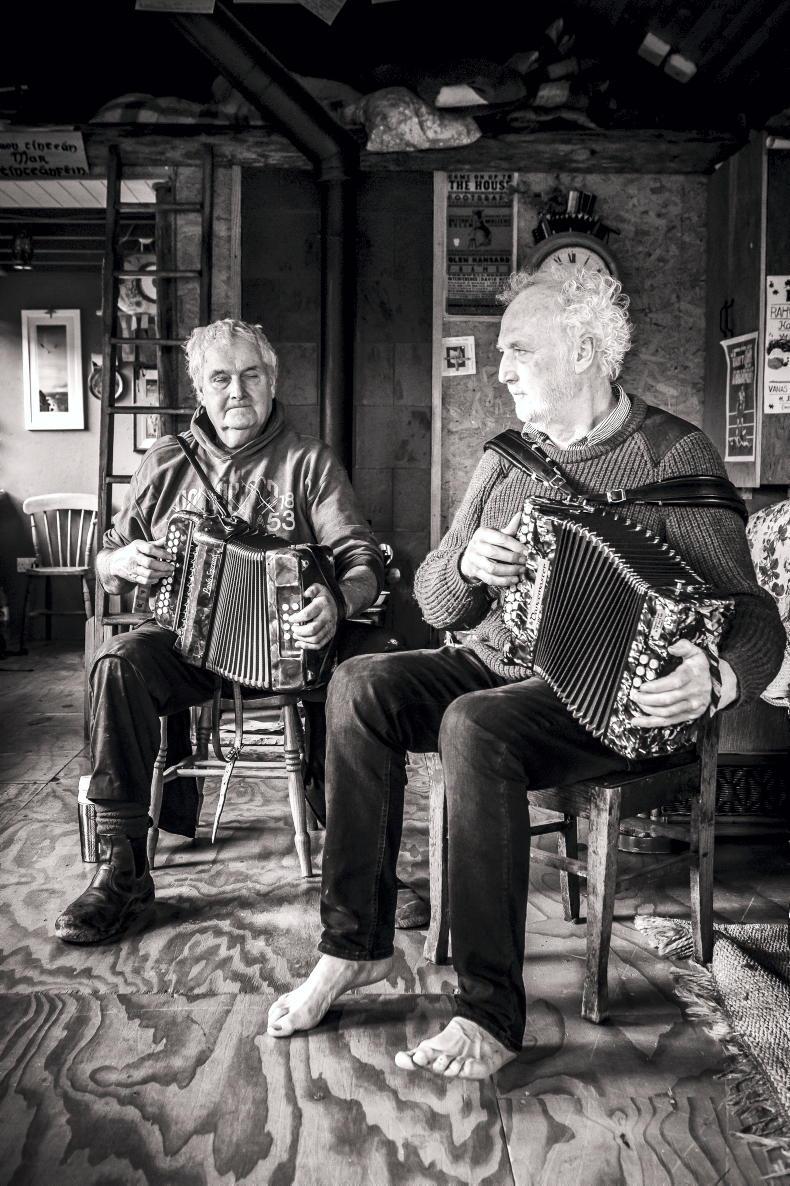
Séamus and Breanndán Ó Beaglaoich spoke virtually no English until they were in their teens. \ Philip Doyle
Even with this small snippet of fun, the situation was not so for Breanndán. Kerry County Council issued him with an enforcement order to remove the structure as it breached planning laws, saying if he didn’t he would face fines of up to €12.6m or jail. At the time Breanndán said he was willing to go to jail, rather than leave his home.
The last remnants
Breanndán says the stance he took on the planning permission was for young Gaeltacht people, many of whom he says can’t get planning permission in the area they’re from.
Both Séamus and Breanndán feel the issue of attaining planning permission on your own land is stifling rural Gaeltacht communities. In their area, they say it’s driving native Irish speakers from the place they were born.
“How can you have a Gaeltacht when you’re not allowing the young people to live in the Gaeltacht?” Breanndán questions. “They’re the next generation, don’t mind us. The predominant language here for a couple of thousand years was the Irish language. Us, we’re the last remnants of it. Our kids are not allowed to live here.
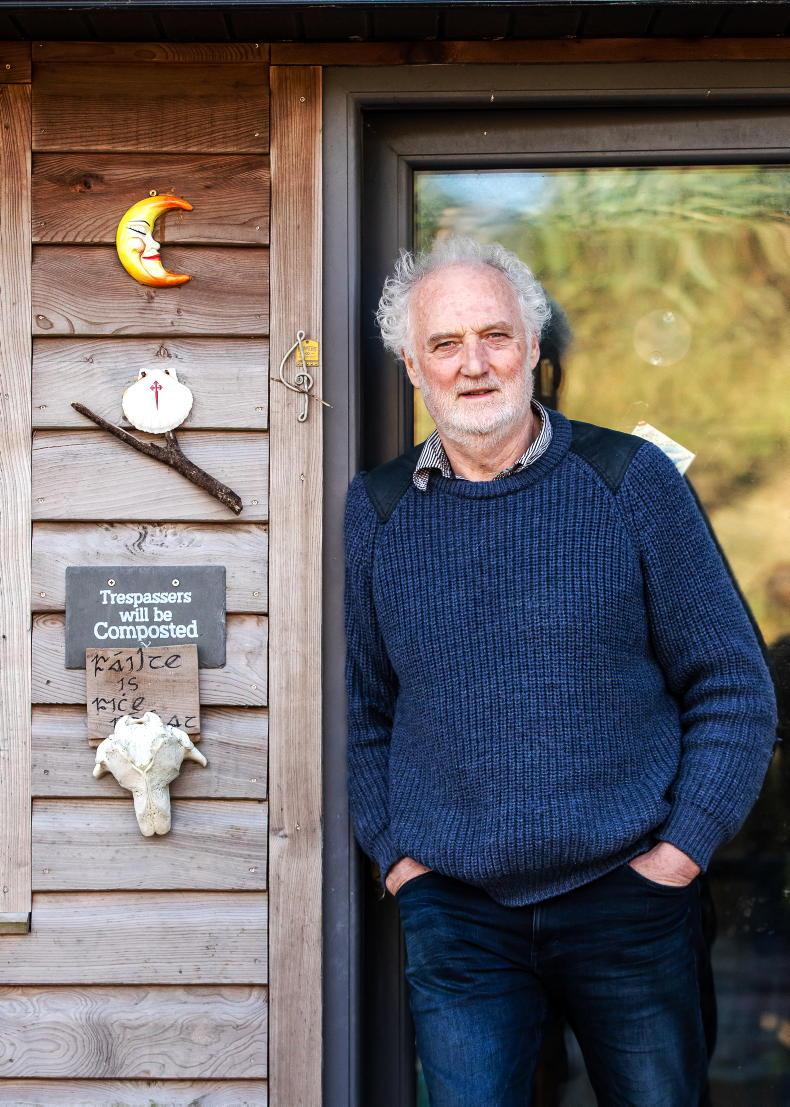
Breanndán Ó Beaglaoich has a love of the sea swimming and rowing. \ Philip Doyle
“That’s the Gaeltacht gone, and why? They say, ‘Can’t you speak Irish inside in Dingle?’ Of course you can speak Irish inside in Dingle, but why?
“The way the laws are now, they’re killing local communities. The way it’s going to happen now is tourists will come in and buy the old houses, because if you were going to sell one of your sheds back there you’d get €100,000 or €200,000 for it,” Breanndán says to his brother.
Séamus counters to me scribbling in my notebook: “Write down ‘Sheds for sale’,” and we all howl with laughter. Even though at times the conversation is serious, it’s punctuated by laughter.
“I’ve no problem with the tourists,” Breanndán further explains, “the tourists come here to meet the people, but after a while it’ll be just tourists meeting tourists.”
When we finish speaking, we take a short excursion to a field at the side of Breanndán’s home. On this piece of land Breanndán erected 235 crosses. Most are white, eight are red. The white crosses represent the population of Baile na bPoc in 1841. The red crosses represent the population now.
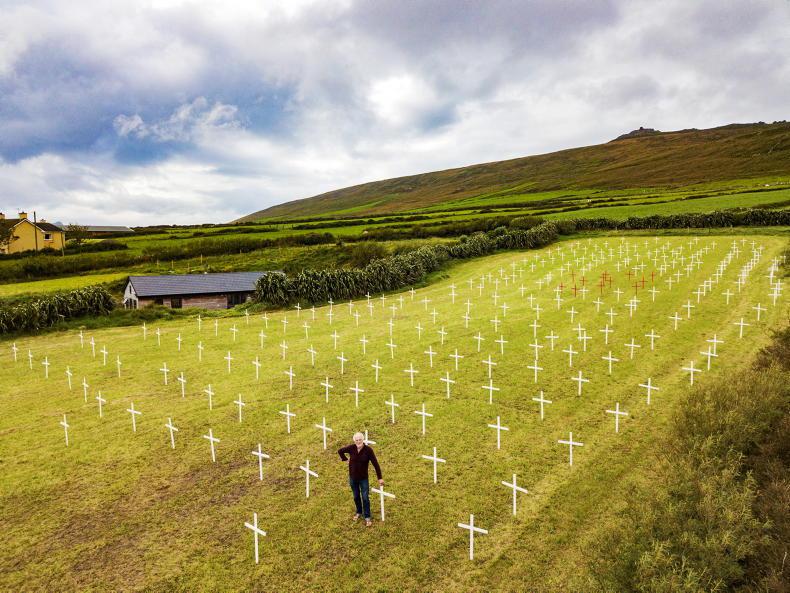
Breanndán Ó Beaglaoich with the 235 crosses in the field beside his home. They represent the population of Baile na bPoc in 1841.
Irish only
Séamus and Breanndán grew up in a family of nine children. They lived on a mixed farm, milking cows as well as keeping sows, sheep and horses. I ask what it was like growing up in Baile na bPoc then.
Breanndán’s answer is: “He was growing up longer than I was.”
On cue, Séamus takes up the mantle.
“There were people everywhere long ago. Droves of people walking back the road every day and on bicycles. There were practically no cars in my time. You’d see a car coming miles away from the dust on the road. There was no tar. We’d see the car out on the road and we’d be all out. Jesus, I’m showing my age now,” he laughs.
Séamus left school at 14 to come home and farm. He milked 30 cows up to 1986 when he got into sucklers and beef, which he describes as a “disaster”. At the moment he rents the land.
Breanndán points out to his brother that he’s still working it, because he can’t stand to see rushes come up or let it slack in anyway.
“What you’ve done to land over there, if our grandfather came back he wouldn’t believe it,” Breanndán says.
Breandán himself was a PE teacher.
Séamus and Breanndán grew up completely through Irish. Up to their teenage years they had virtually no English. When they discuss their language it’s with total passion. Séamus spoke only Irish and some broken English until he left school.
For Breanndán, it was a new introduction to the area that brought the English language.
“For me it was when Seán Thomaseen got the television in 1963. For the first six months I was watching television and I hadn’t a clue what they were saying. What we loved the most were the Cowboys and Indians.
“I was at college in Limerick for four years and we used to have seminars. I never opened my mouth for four years,” Breanndán explains. “We had two seminars every week talking about various things. There’d be about 20 people in the class discussing things and I was so shy, because I had no confidence whatsoever in my Béarla.
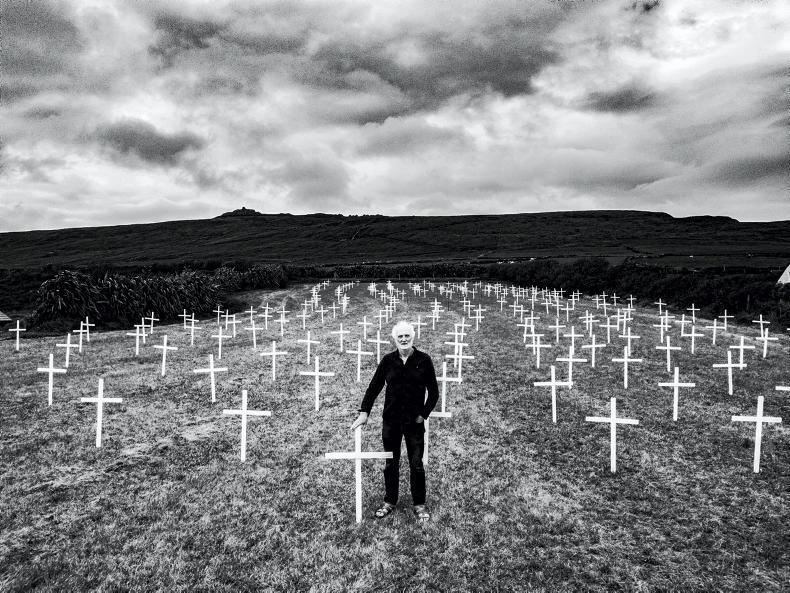
Breanndán Ó Beaglaoich with the 235 crosses in the field beside his home. They represent the population of Baile na bPoc in 1841.
“I remember in college I was reading and I said ‘ja’, it should be ‘jaw’. They all started laughing at me. I had heard it from the Cowboys and Indians: ‘I’ll give you a crack in the ja.’ I said it in an American accent.”
Music makers
The other massive element for the brothers growing up was, of course, music.
“Some houses had football, like Páidí Sé and them. Football was the God in their house, but in our house it was music,” Breanndán says simply.
Their parents sang and played music and so did Séamus, Breanndán and their siblings. In turn, Séamus and Breanndán’s children also play music.
Séamus recounts the story – he laughs that he has told it once too often – of his father and two uncles owning the dance hall three miles from here, Muiríoch Hall, where they all played music.
For the summer the Gael Linns (the equivalent then of students going to Irish College) would be in town.
From the age of 14, Séamus was playing in Muiríoch Hall during the summer. Breandánn started at 16. But even before Séamus got into the family business, he had another paid gig.
“I was actually playing when I was going to school, because there were a few Gael Linns staying in the house and they told the man in charge that I was able to play the accordion. I got my job anyway playing the accordion.
“From then on, for the whole month of July I used to get £10. It was the first time ever I saw £10 all in one piece.”
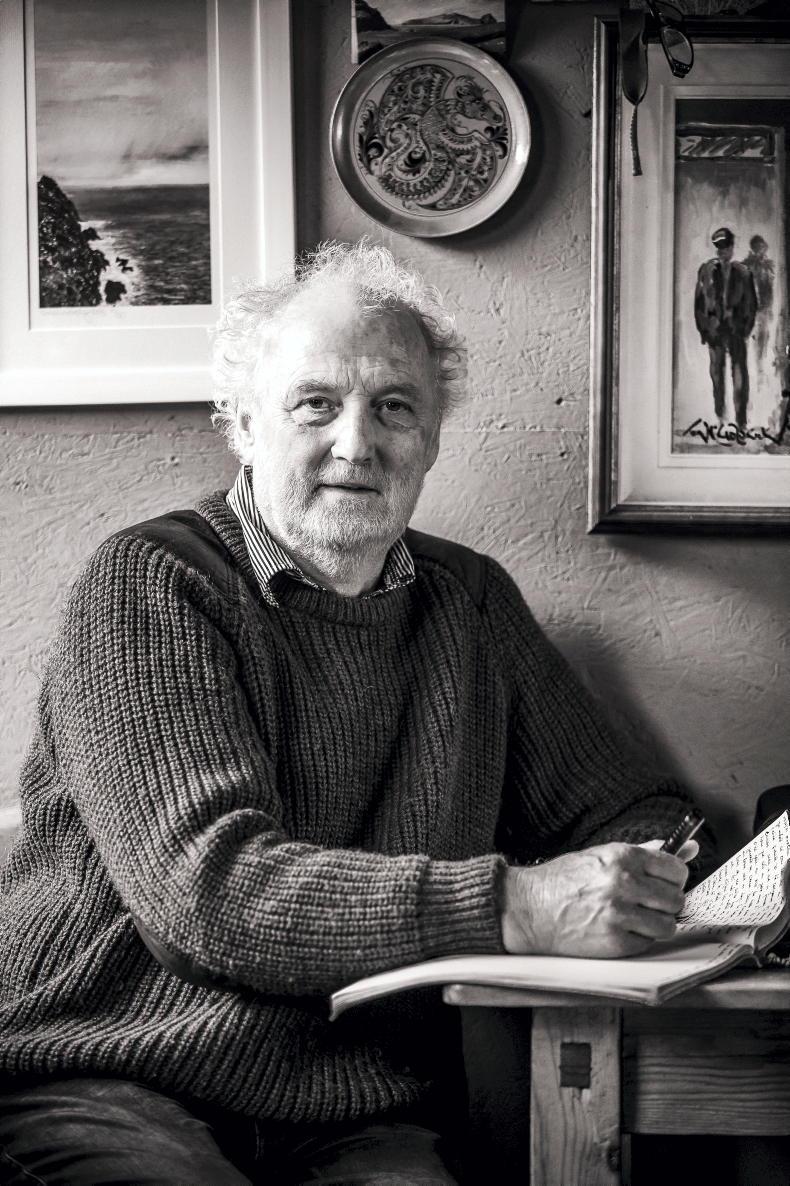
Breanndán Ó Beaglaoich was a PE teacher. \ Philip Doyle
“In Muiríoch we used to play nearly five or six nights a week in the summer. It was fantastic. The finest women coming from all over the country to the Gaeltacht learning Irish. They were teaching us English and teaching us a few more tricks as well,” Séamus says with a glint in his eye.
Breanndán was in on the act too: “Very often you’d be playing at the céilí and they’d be gone by the time you’d be finished. They had to be home by a certain time, they were Gael Linns I suppose. In Muiríoch then my father would be there at the door, you couldn’t really sneak out with a woman. No one went in or out without his permission.”
The stories go on, floating through different adventures and topics. Too many for the parameters of these pages, unfortunately.
In the end, we double back on ourselves and Breanndán sums up some of their sentiments with: “To us there’s no difference between the Irish language, the music, the dance, the stories and the way of life. And the way of life is being destroyed by not letting us live on our own land.
“It’s all the one. They’re looking at it as à la carte – ‘I’ll have that, I won’t have that’. Community doesn’t work like that. To us being able to live in our own villages, on our own land, is important for us to be able to speak our language and play our music.”
Kerry Co Council response
A statement issued to Irish Country Living from Kerry County Council on planning permission for the West Kerry Gaeltacht refuted claims of residents being unable to attain planning permission:
“There were 58 planning application sites for dwellings in the West Kerry Gaeltacht between March 2015 and 31 December 2019.
“Forty-three of these were granted, 17 were refused. Therefore 70.7% of applications for dwellings in the West Kerry Gaeltacht were granted.
“The majority of the West Kerry Gaeltacht is located in an area classified as a Stronger Rural Area under the current County Development Plan. It is an objective of the council in Stronger Rural Areas to: ‘Facilitate the provision of dwellings for persons who are an intrinsic part of the rural community in which they are raised, subject to compliance with normal planning criteria and environmental protection considerations’.
“Kerry County Council is in the process of drafting a new County Development Plan for the next six years and the Gaeltacht and people who live there will continue to be an integral focus therein. An extensive public consultation process on the draft plan will commence very soon.”
Read more
Podcast: Franz Sauerland on Gaeilge, football and experiencing racial abuse
In some ways, they’re total opposites. One loves the sea, the other the land. One favoured books in school, the other not so much. One is solemn and reflective, the other witty and forthright.
But still, despite their seeming differences, in the presence of brothers Séamus and Breanndán Ó Beaglaoich, you get the sense they’re on the same wavelength. That they have a connection perhaps only brothers can. It’s evident in their shared love of music, their shared passion for the Irish language and their common wish to keep rural communities vibrant and viable.

Séamus and Breanndán Ó Beaglaoich at home in Baile na bPoc, Co Kerry. \ Philip Doyle
As we chat, they regularly break into a few lines of Gaeilge between themselves, such is the habit, and then come back to translate. The brothers also have a seanfhocal for every eventuality – too many to start into.
Séamus and Breanndán are well-known traditional musicians from west Kerry, but speaking with them you’d scarcely know it. The only giveaway is the 10 or more accordions scattered around Breanndán’s sitting room.
Both are box players. Our photographer and I are lucky enough to get a short, private concert when we visit them at Breanndán’s home.

Séamus and Breanndán Ó Beaglaoich at home in Baile na bPoc, Co Kerry. \ Philip Doyle
Casually, Breanndán drops into the conversation he was playing in the National Concert Hall with Glen Hansard one night. Séamus has been on tour with Mary Black and in 2013 was the TG4 Amhranaí na Bliana (Singer of the Year). That’s just to give you a small flavour.
As the farmer of the two, Séamus loves the land. Breanndán is more into the sea. He was sea swimming ever before there was mention of a dryrobe and he also rows.
For three consecutive years he completed a Camino, but not the walking pilgrimage that springs to mind. With others he rowed in a Naomhóg, a traditional west Kerry Currach, from Ireland to Wales, onto Cornwall and then down the coast of mainland Europe to Spain and Portugal.
The man who can’t be moved
This home of Breanndán’s is actually in itself sort of famous. It’s situated in the Gaeltacht, 15 minutes outside Dingle, where they’re from in Baile na bPoc. It’s on what was their family farm growing up.
You see, Breanndán was in a 15-year battle for planning permission. He had been attempting to secure planning from Kerry County Council for a house on his land since 2005. Last October, he was granted it after an appeal to An Bord Pleanála.
The key thing that needs to be mentioned at his juncture about Breanndán’s current home, is that it’s built on the back of an articulated trailer. Now, at a glance, one would hardly know it. It has a toilet, a bedroom, a small kitchen and a spacious sitting room.
After 10 years of planning struggles, in 2015 the house on the trailer was born out of total frustration, Breanndán says.

Breanndán Ó Beaglaoich at home in Baile na bPoc, Co Kerry. \ Philip Doyle
“I lived for almost a year in a caravan down there belong ing to Séamus. I started planning this and I said, ‘I’m not going to live in a caravan, I’m going to live in a house.’ I looked at this website called Tiny Homes.
“I decided to build a house, that if all came to all, I could actually move it off the land. I can still move this off the land. I built nothing here, I just drove my truck onto the land.”
Séamus interjects with a laugh: “If you get tired of the neighbours you can move.”
An articulated trailer arrived from Listowel and the house was built on it in Séamus’s yard just a short distance away. At 44ft long and 8ft wide, the house was actually designed and constructed by a ship builder, which is fitting due to Breanndán’s love of the sea.
Séamus tells Breanndán to show us the video. Breanndán finds a tablet and a short time later the distinct sound of accordions blasts from it. The video shows Séamus and Breanndán aloft on a tractor, playing music as the house on the trailer is toed onto the land, cheered on by local people.

Séamus and Breanndán Ó Beaglaoich spoke virtually no English until they were in their teens. \ Philip Doyle
Even with this small snippet of fun, the situation was not so for Breanndán. Kerry County Council issued him with an enforcement order to remove the structure as it breached planning laws, saying if he didn’t he would face fines of up to €12.6m or jail. At the time Breanndán said he was willing to go to jail, rather than leave his home.
The last remnants
Breanndán says the stance he took on the planning permission was for young Gaeltacht people, many of whom he says can’t get planning permission in the area they’re from.
Both Séamus and Breanndán feel the issue of attaining planning permission on your own land is stifling rural Gaeltacht communities. In their area, they say it’s driving native Irish speakers from the place they were born.
“How can you have a Gaeltacht when you’re not allowing the young people to live in the Gaeltacht?” Breanndán questions. “They’re the next generation, don’t mind us. The predominant language here for a couple of thousand years was the Irish language. Us, we’re the last remnants of it. Our kids are not allowed to live here.

Breanndán Ó Beaglaoich has a love of the sea swimming and rowing. \ Philip Doyle
“That’s the Gaeltacht gone, and why? They say, ‘Can’t you speak Irish inside in Dingle?’ Of course you can speak Irish inside in Dingle, but why?
“The way the laws are now, they’re killing local communities. The way it’s going to happen now is tourists will come in and buy the old houses, because if you were going to sell one of your sheds back there you’d get €100,000 or €200,000 for it,” Breanndán says to his brother.
Séamus counters to me scribbling in my notebook: “Write down ‘Sheds for sale’,” and we all howl with laughter. Even though at times the conversation is serious, it’s punctuated by laughter.
“I’ve no problem with the tourists,” Breanndán further explains, “the tourists come here to meet the people, but after a while it’ll be just tourists meeting tourists.”
When we finish speaking, we take a short excursion to a field at the side of Breanndán’s home. On this piece of land Breanndán erected 235 crosses. Most are white, eight are red. The white crosses represent the population of Baile na bPoc in 1841. The red crosses represent the population now.

Breanndán Ó Beaglaoich with the 235 crosses in the field beside his home. They represent the population of Baile na bPoc in 1841.
Irish only
Séamus and Breanndán grew up in a family of nine children. They lived on a mixed farm, milking cows as well as keeping sows, sheep and horses. I ask what it was like growing up in Baile na bPoc then.
Breanndán’s answer is: “He was growing up longer than I was.”
On cue, Séamus takes up the mantle.
“There were people everywhere long ago. Droves of people walking back the road every day and on bicycles. There were practically no cars in my time. You’d see a car coming miles away from the dust on the road. There was no tar. We’d see the car out on the road and we’d be all out. Jesus, I’m showing my age now,” he laughs.
Séamus left school at 14 to come home and farm. He milked 30 cows up to 1986 when he got into sucklers and beef, which he describes as a “disaster”. At the moment he rents the land.
Breanndán points out to his brother that he’s still working it, because he can’t stand to see rushes come up or let it slack in anyway.
“What you’ve done to land over there, if our grandfather came back he wouldn’t believe it,” Breanndán says.
Breandán himself was a PE teacher.
Séamus and Breanndán grew up completely through Irish. Up to their teenage years they had virtually no English. When they discuss their language it’s with total passion. Séamus spoke only Irish and some broken English until he left school.
For Breanndán, it was a new introduction to the area that brought the English language.
“For me it was when Seán Thomaseen got the television in 1963. For the first six months I was watching television and I hadn’t a clue what they were saying. What we loved the most were the Cowboys and Indians.
“I was at college in Limerick for four years and we used to have seminars. I never opened my mouth for four years,” Breanndán explains. “We had two seminars every week talking about various things. There’d be about 20 people in the class discussing things and I was so shy, because I had no confidence whatsoever in my Béarla.

Breanndán Ó Beaglaoich with the 235 crosses in the field beside his home. They represent the population of Baile na bPoc in 1841.
“I remember in college I was reading and I said ‘ja’, it should be ‘jaw’. They all started laughing at me. I had heard it from the Cowboys and Indians: ‘I’ll give you a crack in the ja.’ I said it in an American accent.”
Music makers
The other massive element for the brothers growing up was, of course, music.
“Some houses had football, like Páidí Sé and them. Football was the God in their house, but in our house it was music,” Breanndán says simply.
Their parents sang and played music and so did Séamus, Breanndán and their siblings. In turn, Séamus and Breanndán’s children also play music.
Séamus recounts the story – he laughs that he has told it once too often – of his father and two uncles owning the dance hall three miles from here, Muiríoch Hall, where they all played music.
For the summer the Gael Linns (the equivalent then of students going to Irish College) would be in town.
From the age of 14, Séamus was playing in Muiríoch Hall during the summer. Breandánn started at 16. But even before Séamus got into the family business, he had another paid gig.
“I was actually playing when I was going to school, because there were a few Gael Linns staying in the house and they told the man in charge that I was able to play the accordion. I got my job anyway playing the accordion.
“From then on, for the whole month of July I used to get £10. It was the first time ever I saw £10 all in one piece.”

Breanndán Ó Beaglaoich was a PE teacher. \ Philip Doyle
“In Muiríoch we used to play nearly five or six nights a week in the summer. It was fantastic. The finest women coming from all over the country to the Gaeltacht learning Irish. They were teaching us English and teaching us a few more tricks as well,” Séamus says with a glint in his eye.
Breanndán was in on the act too: “Very often you’d be playing at the céilí and they’d be gone by the time you’d be finished. They had to be home by a certain time, they were Gael Linns I suppose. In Muiríoch then my father would be there at the door, you couldn’t really sneak out with a woman. No one went in or out without his permission.”
The stories go on, floating through different adventures and topics. Too many for the parameters of these pages, unfortunately.
In the end, we double back on ourselves and Breanndán sums up some of their sentiments with: “To us there’s no difference between the Irish language, the music, the dance, the stories and the way of life. And the way of life is being destroyed by not letting us live on our own land.
“It’s all the one. They’re looking at it as à la carte – ‘I’ll have that, I won’t have that’. Community doesn’t work like that. To us being able to live in our own villages, on our own land, is important for us to be able to speak our language and play our music.”
Kerry Co Council response
A statement issued to Irish Country Living from Kerry County Council on planning permission for the West Kerry Gaeltacht refuted claims of residents being unable to attain planning permission:
“There were 58 planning application sites for dwellings in the West Kerry Gaeltacht between March 2015 and 31 December 2019.
“Forty-three of these were granted, 17 were refused. Therefore 70.7% of applications for dwellings in the West Kerry Gaeltacht were granted.
“The majority of the West Kerry Gaeltacht is located in an area classified as a Stronger Rural Area under the current County Development Plan. It is an objective of the council in Stronger Rural Areas to: ‘Facilitate the provision of dwellings for persons who are an intrinsic part of the rural community in which they are raised, subject to compliance with normal planning criteria and environmental protection considerations’.
“Kerry County Council is in the process of drafting a new County Development Plan for the next six years and the Gaeltacht and people who live there will continue to be an integral focus therein. An extensive public consultation process on the draft plan will commence very soon.”
Read more
Podcast: Franz Sauerland on Gaeilge, football and experiencing racial abuse













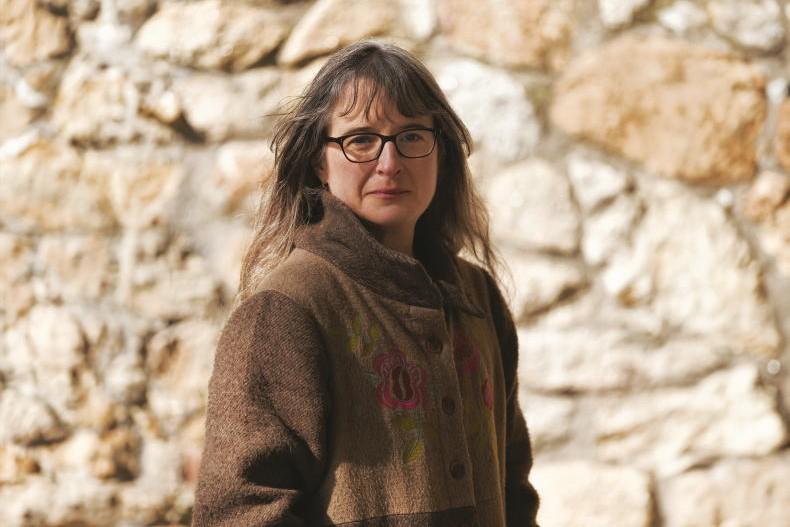

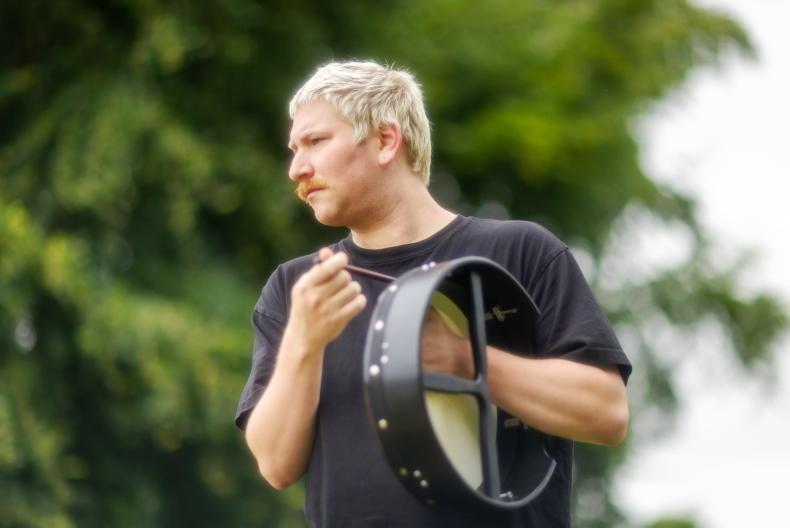

SHARING OPTIONS